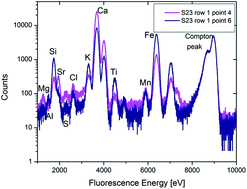Mortar samples from the Abbey of Saint John at Müstair: a combined spatially resolved X-ray fluorescence and X-ray absorption (XANES) study
Abstract
Three mortar samples from the Abbey of Saint John, in the Swiss village of Müstair have been investigated. Two samples were taken from Carolingian plaster and the third one from a late Gothic plaster. All three samples were embedded in a synthetic resin (Araldite 2020) to be prepared as thin sections. The samples were pre-characterized using polarized light microscopy and some standard wet chemical procedures for determining in an indirect way the various chemical compounds in the samples. These experiments indicated differences between the samples in the composition of the binder materials (hydraulic and dolomitic components for the Carolingian samples, pure dolomitic lime for the Gothic sample) as well as in the composition of the aggregates that came, however, in all cases from local river sand. Using synchrotron radiation (SR) from the Canadian Light Source the three samples were investigated using spatially resolved (∼300 × 300 μm2 resolution) SR excited X-ray fluorescence (XRF) with an excitation energy of 9 keV. For some selected elements (Ca and Fe) X-ray absorption near edge structure (XANES) spectroscopy was used as well. Ca and Fe have the highest fluorescence intensity for all investigated points (at least 26 per sample) for all three samples and thus they are besides Si the most abundant elements. There are correlations between the XRF intensities of Mg, Sr and Ca and Fe and Si indicating chemical bonds between these elements. As there is no positive correlation between the intensities of Al, Si and Ca significant contributions of calcium-silicates and calcium-aluminates as sources for hydraulic setting can be ruled out. The analysis of the Ca-K-edge XANES spectra showed that calcite is the dominant form for Ca in the samples; however for “white spots” Ca is also available in the form of vaterite and for “dark spots” in the form of hydroxyapatite. Also Fe is observed in different forms in the white and dark spots: for both types of spots valence +3 as in Fe2O3 is the dominant form; however, in white spots fits are significantly improved by adding contributions from Fe3O4 and for the dark spots by adding FeO. The above summarized observations are correct for the Carolingian samples as well as for the Gothic sample. No significant age dependent differences were observed.

- This article is part of the themed collection: Synchrotron radiation and neutrons in art and archaeology

 Please wait while we load your content...
Please wait while we load your content...